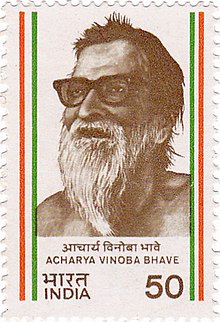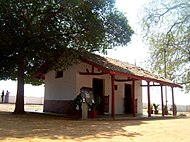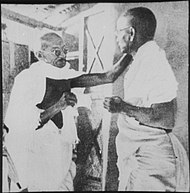Vinoba Bhave
Vinoba Bhave | |
|---|---|
 Bhave on a 1983 stamp of India | |
| Born | Vinayak Narahari Bhave 11 September 1895 |
| Died | 15 November 1982(aged 87) Pavnar,Wardha,Maharashtra,India |
| Nationality | • • |
| Other names | Acharya |
| Alma mater | Maharaja Sayajirao University of Baroda[1] |
| Known for | Individual Satyagraha,Bhoodan Movement |
| Honours | Ramon Magsaysay Award(1958) Bharat Ratna(1983) |
| Website | vinobabhave |
Vinayak Narahari Bhave,also known asVinoba Bhave(;11 September 1895 – 15 November 1982), was an Indian advocate ofnonviolenceand human rights. Often calledAcharya(Teacher inSanskrit), he is best known for theBhoodan Movement.He is considered as National Teacher of India and thespiritual successorofMahatma Gandhi.He was an eminent philosopher. The Gita has been translated into the Marathi language by him with the titleGeetai(meaning 'Mother Gīta' inMarathi).[2]
Early life and background[edit]
Vinayak Narahari Bhave was born on 11 September 1895 in a small village called Gagoji (present-day Gagode Budruk) inKolabain theKonkanregion of what is nowMaharashtra.Vinayaka was the eldest son of Narahari Shambhu Rao and Rukmani Devi. The couple had five children; four sons named Vinayaka (affectionately called Vinya), Balakrishna, Shivaji and Dattatreya, and one daughter. His father was a trained weaver with a modern rationalist outlook and worked inBaroda.Vinayaka was brought up by his grandfather, Shamburao Bhave and was greatly influenced by his mother Rukmini Devi, a religious woman fromKarnataka.Vinayaka was highly inspired after reading theBhagavad Gita,at a very young age.[3]
A report in the newspapers about Gandhi's speech at the newly foundedBanaras Hindu Universityattracted Bhave's attention. In 1916, after reading a newspaper piece by Mahatma Gandhi, Bhave threw his school and college certificates into a fire on his way toBombayto appear for theintermediate examination. He wrote a letter to Gandhi and after an exchange of letters, Gandhi advised Bhave to come for a personal meeting atKochrab AshraminAhmedabad.Bhave met Gandhi on 7 June 1916 and subsequently abandoned his studies. Bhave participated with a keen interest in the activities at Gandhi'sashram,like teaching, studying, spinning and improving the lives of the community. His involvement with Gandhi's constructive programmes related toKhadi,village industries, new education (Nai Talim), sanitation and hygiene also kept on increasing.
Bhave went toWardhaon 8 April 1921 to take charge of the Ashram as desired by Gandhi. In 1923, he brought outMaharashtra Dharma,a Marathi monthly which had his essays on the Upanishads. Later on, this monthly became a weekly and continued for three years. In 1925, Gandhi sent him toVaikom,Kerala to supervise the entry of theHarijansto the temple.
Bhave was arrested several times during the 1920s and 1930s and served a five-year jail sentence in the 1940s for leading non-violent resistance toBritish rule.The jails for Bhave had become the places of reading and writing. He wrote Ishavasyavritti and Sthitaprajna Darshan in jail. He also learnt four South Indian languages and created the script of Lok Nagari atVellorejail. In the jails, he gave a series of talks on the Bhagavad Gita in Marathi, to his fellow prisoners. Bhave participated in the nationwide civil disobedience periodically conducted against the British and was imprisoned with other nationalists. Despite these many activities, he was not well known to the public. He gained national prominence when Gandhi chose him as the first participant in a new nonviolent campaign in 1940. All were calling him by his short name, Vinoba. Bhave's younger brother Balkrishna was also a Gandhian. Gandhi entrusted him andManibhai Desaito set up a nature therapy ashram atUrali Kanchanwhere Balkrishna spent all his life.[4][5][6][7]
Career[edit]
Freedom struggle[edit]

He was associated withMahatma Gandhiin theIndian independence movement.He stayed for some time at Gandhi's Sabarmati ashram in a cottage that was named after him, 'Vinoba Kutir'. He gave talks on the Bhagavad Gita in Marathi to his fellow ashramites. These were later published in book form, asTalks on the Gita,and it has been translated into many languages both in India and elsewhere. Bhave felt that the source of these talks was something from above and he believed that its influence would endure even if his other works were forgotten.
In the year 1940, he was chosen by Gandhi to be the first individual Satyagrahi (an individual standing up for Truth instead of acollective action) against the British rule.[8]It is said that Gandhi envied and respected Bhave's celibacy, a vow he made in his adolescence, in fitting with his belief in theBrahmacharyaprinciple. Bhave also participated in theQuit India Movement.
Religious and social work[edit]

Bhave's religious outlook was very broad and it synthesized the truths of many religions. This can be seen in one of his hymns "Om Tat Sat" which contains symbols of many religions. His slogan "जय जगत्" (Jay Jagat) i.e. "victory to the world" finds reflection in his views about the world as a whole.
Bhave observed the life of the average Indian living in a village and tried to find solutions for the problems he faced with a firm spiritual foundation. This formed the core of hisSarvodaya movement.Another example of this is theBhoodan(land gift) movement started atPochampallyon 18 April 1951, after interacting with 80 Harijan families. He walked all across India asking people with land to consider him one of their sons and so gave him one-sixth of their land which he then distributed to the landless poor.Non-violenceand compassion is a hallmarks of his philosophy, he also campaigned against the slaughtering of cows.
Bhave said, "I have walked all over India for 13 years. In the backdrop of the enduring perpetuity of my life's work, I have established 6 ashrams."
Brahma Vidya Mandir (BVM)[edit]
The Brahma Vidya Mandir was founded in 1959 in Paunar, Maharashtra and is one of the ashrams established by Bhave. It was created for women to become self-sufficient and practice non-violence within the community. They used Gandhi's beliefs, which was heavily influenced by theBhagavad-Gita,to aid in agricultural practices that were non-violent and produce sustainable food. The community performed prayers as a group every day, reciting from theIsha Upanishadat dawn, theVishnu Sahasranamaat mid-morning, and theBhagavad-Gitain the evening. As of today, there are around 25 women who are members of the community and several men have also been allowed to join the community.[9]
BVM's existence demonstrates how a self sufficient community can apply non-violence and radical democracy to their own social and geographic context in food production. One mainstream narrative is that large-scale agriculture is "inevitable, necessary, and the sole possibility of feeding the world" and relies on expensive technology. However, BVM rejects this narrative and continues to use Gandhian principles in agriculture such as nonviolence. It is a small community in India and does not hold much influence to promote its beliefs and practices in the mainstream. Most agricultural practices in India has adopted US-style consumerism. BMV is still important as its ideals can help shape agriculture for the better and focus less on profit.[9]
Literary career[edit]
Vinoba Bhave was a scholar, thinker, and writer who produced numerous books. He was a translator who made Sanskrit texts accessible to the common man. He was also an orator and linguist with an excellent command of several languages (Marathi, Kannada, Gujarati, Hindi, Urdu, English, and Sanskrit).
Bhave was an innovative social reformer. He called "Kannada" script the "Queen of World Scripts" (Vishwa Lipigala Raani).[10][11]He wrote brief introductions to, and criticisms of, several religious and philosophical works like the Bhagavad Gita, works ofAdi Shankaracharya,theBibleand theQuran.His views of Dnyaneshwar's poetry and works by other Marathi saints are pretty brilliant and a testimony to the breadth of his intellect.
Bhave had translated the Bhagavad Gita into Marathi. He was deeply influenced by the Gita and attempted to imbibe its teachings into his life, often stating that "The Gita is my life's breath".[12]
Vinoba Bhave University,located inHazaribagh districtin the state ofJharkhand,is named after him.
Vinoba Bhave and Land Donation Movement[edit]
On 18 April 1951,[13]Bhave started his land donation movement at Pochampally of Nalgonda districtTelangana,[14]theBhoodan Movement.He took donated land from landowner Indians and gave it away to the poor and landless, for them to cultivate. Then after 1954, he started to ask for donations from whole villages in a programme he called Gramdan. He got more than 1000 villages by way of donations. Out of these, he obtained 175 donated villages in Tamil Nadu alone. Noted Gandhian and an atheistLavanamwas the interpreter for Bhave during his land reform movement in Andhra Pradesh and parts of Orissa.[15]
Later life and death[edit]

Bhave spent the later part of his life at his Brahma Vidya Mandir ashram in Paunar inWardha districtof Maharashtra. He died on 15 November 1982 after refusing food and medicine for a few days by accepting "Samadhi Maran" / "Santhara"as described inJainism.[16]Then the Prime Minister of India,Indira Gandhi,who was visiting Moscow to attend the funeral of Soviet leaderLeonid Brezhnev,cut short her visit to be at the Bhave's funeral.[17]
Criticism[edit]
V.S. Naipaulhas scathingly criticised Bhave in his collection of essays citing his lack of connection with rationality and excessive imitation of Gandhi. Even some of his admirers find fault with the extent of his devotion to Gandhi. Much more controversial was his support, ranging from covert to open, to the Congress Party's government under Indira Gandhi, which was fast becoming unpopular. He controversially backed theIndian Emergencyimposed by Prime MinisterIndira Gandhi,calling itAnushasana Parva(Time for Discipline).Jayaprakash Narayanin his prison diary during the emergency sarcastically wrote about the meaning of Anushasan Parva.[18]Congress party opponents at that time had coined the derogatory term "Sarkari Sant (Government Saint)" to describe him. Noted Marathi writerPra Ke Atrepublicly criticised him and mocked him by writing an article titled "Vanaroba" which is a disambiguation of the name "Vinoba" and meansmonkey.
Awards and recognition[edit]
In 1958 Bhave was the first recipient of the internationalRamon Magsaysay Awardfor Community Leadership.[19]He was awarded theBharat Ratnaposthumously in 1983.[20]
Vinoba Bhave, The Man,a documentary film on the social-reformer directed byVishram Bedekarwas released in 1963. It was produced by theGovernment of India'sFilms Division.[21]Indian film directorSarvottam Badamihad earlier made another documentary on him,Vinoba Bhave,in 1951.[22]
Select bibliography[edit]
- — (1957).Bhoodan Yajna: Land-Gifts Mission.Navajivan Publ. House.OCLC917003189.
- — (1969).The Essence of the Christian Teachings.Sangh.OCLC916980559.
- — (1972).The Third Power.Sangh.OCLC916982570.
- — (1973).Swaraj Sastra: The Principles of A Non-Violent Political Order.Sangh.OCLC916982656.
- — (1977).Democratic Values and the Practice of Citizenship: Selections from the Addresses of Vinoba Bhave, 1951-1960.Sarva Seva Sangh Prakashan.OCLC312995346.
- — (1977).Dharma Samanvaya(in Hindi). Naī Dillī; Gāṃdhī Śānti Pratiṣṭhāna.OCLC314472587.
- — (1978).The Essence of the Quran.Sangh.OCLC916980560.
- — (1982).Talks on the Gita(8th ed.). Sarva-Seva-Sangh-Prakashan.OCLC20472526.
- — (1982).Women's Power.Sangh.OCLC916980145.
- — (1985).Thoughts on Education.Sarva Seva Sangh Prakashan.OCLC311456183.
- — (2006).Moved By Love.Translated by Sykes, Marjorie. P. Cholkar.OCLC875768248.
See also[edit]
References[edit]
- ^Umarji, Vinay (13 June 2016),"Know Your Smart City: Gujarat",Business Standard
- ^"Geetai".
- ^Narayanaswamy, K.S. (2000).Acharya Vinoba Bhave – A biography (Immortal Lights series).Bangalore: Sapna Book House.ISBN9788128017506.
- ^Kumarappa B. ed. (1954)Gandhi M. Nature cure.Navajivan Publishing House.
- ^"The Nisargopachar Ashram – Naturopathic Centre Urulikanchan, Pune".aarogya.
- ^"Desai, Manibhai Bhimbhai".rmaf.org.ph.
- ^Mehta, Jayshree; Usha, Thakkar, eds. (2011).Understanding Gandhi: Gandhians in conversation with Fred J. Blum.Los Angeles: Sage Publications. p. 6.ISBN978-8132105572.
- ^Rühe, Peter (2001).Gandhi.Phaidon. p. 152.ISBN978-0-7148-4103-8.
- ^abSanford, A. Whitney (3 April 2013). "Gandhi's Agrarian Legacy: Practicing Food, Justice, and Sustainability in India".Journal for the Study of Religion, Nature and Culture.7(1): 65–87.doi:10.1558/JSRNC.V7I1.65.S2CID144900086.
- ^"Kannada Language: Check These 7 Amazing Facts About The Queen of Languages!".Jagranjosh.28 April 2022.Retrieved26 November2022.
- ^Chai, The Masala (3 June 2021)."Kannada Is Known As The 'Queen of World Scripts': Vinoba Bhave".Masala Chai Media.Retrieved26 November2022.
- ^Minor, Robert (1986)Modern Indian Interpreters of the Bhagavad Gita.State University of NY press.ISBN978-0-88706-298-8
- ^mkgandhi.org
- ^The Un-Gandhian Gandhi: The Life and Afterlife of Mahatma– By Claude Markovits
- ^"The King of Kindness: Vinoba Bhave and His Nonviolent Revolution".Markshep. Archived fromthe originalon 14 January 2010.Retrieved13 June2012.
- ^Justice, Christopher (1 January 1997).Dying the Good Death: The Pilgrimage to Die in India's Holy City.SUNY Press.ISBN978-0-7914-3261-7.
- ^Wilson, Boyd H. (1986). "Vinoba Bhave's Talks on the Gita". In Minor, Robert Neil (ed.).Modern Indian Interpreters of the Bhagavadgita.State University of New York Press. p. 113.ISBN978-0-88706-297-1.OCLC751652796.
- ^Dandavate, Madhu (2002).Jayaprakash Narayan: struggle with values: a centenary tribute.New Delhi: Allied Publishers. pp. 224–225.ISBN9788177643411.
- ^Biography of Vinoba Bhave.rmaf.org.ph
- ^List of Bharat Ratna Awardees recipientsaccessed in January 2010
- ^"Vinoba Bhave The Man - Films Division".Ministry of Information and Broadcasting.
- ^Rajadhyaksha, Ashish; Willemen, Paul (1999).Encyclopaedia of Indian cinema.British Film Institute.ISBN9780851706696.Retrieved12 August2012.
Further reading[edit]
- Vinoba Bhave: The Man and His Mission,by P. D. Tandon. Published by Vora, 1954.
- India's Walking Saint: The Story of Vinoba Bhave,by Hallam Tennyson. Published by Doubleday, 1955.
- Acharya Vinoba Bhave,by Ministry of Information and Broadcasting, India, Published by Publications Division, Government of India, 1955.
- India's Social Miracle: The Story of Acharya Vinoba Bhave and His Movement for Social Justice and Cooperation, Along with a Key to America's Future and the Way for Harmony Between Man, Nature, and God,by Daniel P. Hoffman. He is published by Naturegraph Co., 1961.
- Sarvodaya Ideology & Acharya Vinoba Bhave,by V. Narayan Karan Reddy. Published by Andhra Pradesh Sarvodaya Mandal, 1963.
- Vinoba Bhave on self-rule & representative democracy,by Michael W. Sonnleitner. Published by Promilla & Co., 1988.ISBN978-81-85002-10-1.
- Struggle for Independence: Vinoba Bhave,by Shiri Ram Bakshi. Published by Anmol Publications, 1989.
- Philosophy of Vinoba Bhave: A New Perspective in Gandhian Thought,by Geeta S. Mehta. Published by Himalaya Pub. House, 1995.ISBN978-81-7493-054-5.
- Vinoba Bhave – Vyakti Ani Vichar(a book in Marathi) by Dr Anant D. Adawadkar, Published by Jayashri Prakashan, Nagpur.
- Vinoba Darshan– a pictorial biography with philosophical views
External links[edit]
- Vinoba Bhave's Geetai Audio Book
- Vinoba Bhave's Geetai PDF
- Website to spread the thoughts, philosophy and works of Vinoba Bhave
- The King of Kindness: Vinoba Bhave and His Nonviolent RevolutionArchived14 January 2010 at theWayback Machine
- Citation for 1958 Ramon Magsaysay Award for Community Leadership
- Vinoba Bahve – his work on leprosy (with photo 1979)
- A Man on Foot – Time magazine cover page article dated Monday, 11 May 1953
- 1895 births
- 1982 deaths
- Indian religious writers
- Marathi-language writers
- 20th-century Indian philosophers
- Indian independence activists from Maharashtra
- Indian independence activists
- Ramon Magsaysay Award winners
- Recipients of the Bharat Ratna
- Indian nonviolence advocates
- Gandhians
- People from Raigad district
- 20th-century Indian translators
- Sanskrit writers
- 20th-century Indian educators
- Indian male writers
- Writers from Maharashtra
- Indian political writers
- 20th-century Indian non-fiction writers
- Translators of the Bhagavad Gita
- Maharaja Sayajirao University of Baroda alumni
